
Winter conditions may cause customers with older vehicles to have concerns regarding vehicle start-up, battery efficiency, and oil leaks. In cold weather, a combination of several small problems can become a large one. If the little things are ignored, they can lead to bigger problems down the road. For example, a vehicle with the wrong viscosity oil and an older battery may start and run fine at 50° F, but at 32° F or lower, (such as on a very cold morning) a drained battery may occur. Cold cranking amperage is a measure of a battery’s ability to start a car in cold weather when thickened engine oil and slowed chemical reactions make starting most difficult.
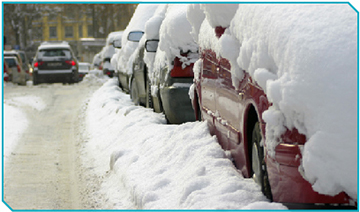
Batteries and Cold Weather
Lead acid batteries convert the battery water (electrolyte) into electrical energy. This process slows down in colder temperatures. Factors such as extreme temperatures can affect the health of a battery. A fully charged battery that has 100% of its cranking power at 80° F has only 65% left at 32° F and 40% left at 0° F. Harsh weather may cause slow cranking when your customer tries to start his or her vehicle. If a vehicle’s battery is not fully charged during extremely cold and icy conditions, the battery fluid may freeze and damage the battery. To maintain maximum efficiency, the battery should be checked regularly with a battery diagnostic test.
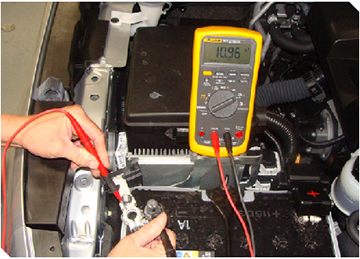
Cold Weather and Oil Leaks
Extremely cold temperatures can affect oil seals. Older vehicles may be particularly prone to this condition since the seals are less flexible from aging. The materials used in seals tend to harden as ambient (outside) temperatures drop. This can make it difficult for a seal to conform to a sealing surface.
When you combine a cold, hardened seal with higher than normal cold oil pressures, leaks can occur. Customers should be advised to let the engine warm up for a minute and then take it easy for the first few miles of driving during colder than normal ambient temperatures. This can help to avoid these problems.
NOTE: Vehicles operating with repeated short distance driving at cold outside temperatures may require more frequent oil and filter changes.
Advanced Driver Assist Systems Maintenance
Newer vehicles may experience the same concerns as older vehicles in icy, cold or wet weather conditions. The following information will focus on newer systems that may be affected by extreme weather.
The Distance Control Assist system may not detect a vehicle in front during certain road conditions or overcome poor visibility in rain, fog or other bad weather. The system is primarily intended for use on straight, dry, open roads with light traffic. The Intelligent Technology Suite (ITS) system is sensitive to heavy rains and wet surfaces (this is stated in the Owner’s Manual). Customers may comment that the system is not working properly or note that the system shuts off when no objects are detected.
Keeping the outside of a vehicle clean is normally the furthest thing from a customer’s mind in cold weather. However, if snow, mud or dirt is allowed to build up on the vehicle, some of the systems will shut down and/or warning lights will illuminate on the instrument panel. You can inform your customers about what can be done to help keep these systems working properly and what effect icy, extremely cold or wet weather may have on their vehicles.
Intelligent Cruise Control
When the windshield wipers are operated in the high speed (HI) position, the Intelligent Cruise Control system is automatically canceled. If the vehicle is equipped with a rain sensing auto wiper, the system may cancel when the wipers are set to the AUTO position.
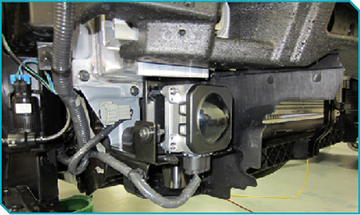
RearView and Around View® Monitors
The Around View® monitor uses four cameras: the front camera mounted in the grille, the rear camera mounted on the trunk lid and two side cameras mounted on the outside mirrors. On some vehicles, the rear camera also has a washer function added to it that will wash and dry the camera lens as needed.
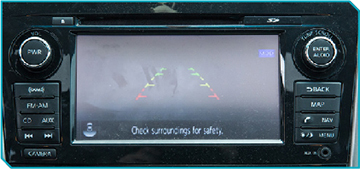
NOTE: When the temperature is extremely low, the screen may not clearly display objects. This is not a malfunction.
The camera unit may detect the reflected image of vehicles or roadside objects that are not actually in the detection zone especially when the road is wet.
Some things to remember about the Around View® and RearView monitor and inform your customer about are:
- The screen displayed on the Around View® Monitor will automatically return to the previous screen three minutes after the CAMERA button has been pressed with the shift lever in a position other than the R (Reverse) position.
- When the view is switched, the display images on the screen may take some time to display.
- When the temperature is extremely high or low, the screen may not display objects clearly. This is not a malfunction.
- When strong light directly shines on the camera, objects may not be displayed clearly. This is not a malfunction.
- The screen may flicker under fluorescent light. This is not a malfunction.
- The colors of objects on the Around View® Monitor may differ somewhat from the actual colors of objects. This is not a malfunction.
- Objects on the Around View® Monitor may not be clear, and the color of the object may differ in a dark environment. This is not a malfunction.
- There may be differences in sharpness between each camera view of the bird’s-eye view.
- If dirt, rain or snow accumulates on the camera, the Around View® Monitor may not display objects clearly. Clean the camera.
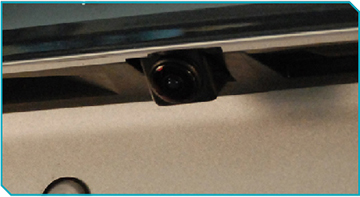
When cleaning the camera lenses:
- Do not use alcohol, benzene or thinner to clean the camera. This will cause discoloration. To clean the camera, wipe with a cloth dampened with a diluted mild cleaning agent and then wipe with a dry cloth.
- Do not damage the camera as the monitor screen may be adversely affected.
- Do not use wax on the camera lens.
NOTE: Car wash spray wax may also create a buildup.
Wipe off any wax with a clean cloth dampened with mild detergent diluted with water.
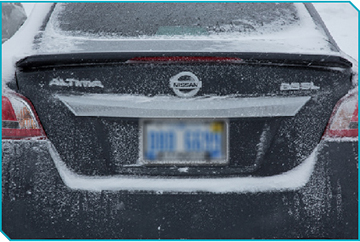
Vehicles Equipped with the Automatic Washer and Blower
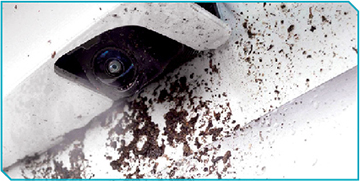
If the camera lens is excessively dirty, the automatic washer may not be able to completely clean the lens. This could result in the camera not detecting vehicles or lane markers. If this occurs, the Blind Spot Warning (BSW) and/or Lane Departure Warning (LDW) system will be turned off automatically. The BSW light (white) and/or LDW light (orange) will blink, and “Unavailable: Clean rear camera” will appear in the vehicle information display.
Normally, this is due to a low washer fluid level. A “Washer fluid low” warning will appear in the vehicle information display. If the LDW/BSW white icons in the dash blink and/or the “Clean camera” message appears in the vehicle information display and the washer fluid is OK, test the washer pump related to the camera cleaning system located in the trunk. Other possible causes could be the pump Electronic Control Unit (ECU) in the trunk and/or the washer hoses. Make sure the fluid is properly getting to the camera cleaning system.
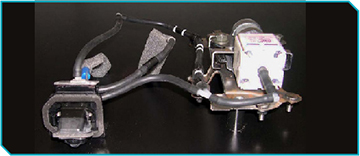
IN-CABIN MICROFILTER
If a vehicle is equipped with an in-cabin microfilter, make sure the air conditioner heats, defogs and ventilates efficiently. Replace the filter in accordance with the maintenance schedule in the NISSAN Service and Maintenance Guide.
NOTE: The filter should be replaced if airflow is extremely decreased or when windows fog up easily when operating the heater or air conditioning system.
Wipers
Weather plays a big part in wiper blade condition. Freezing temperatures can make the rubber in wiper blades hard and brittle, which may attribute to cracking or tearing. Using wiper blades that are specially designed for use when driving in cold weather is suggested.
During snowy, icy weather, it is sometimes a practice to lift the wiper blades off the windshield to scrape the windshield or overnight to keep the blades from freezing on the windshield. When lifting the wiper arm or servicing wiper blades on some vehicles, damage to the hood may occur if you attempt to lift the wiper arms without first selecting the wiper service position.
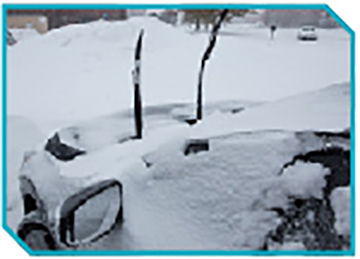
NOTE: Be sure to return the wiper arm gently to the windshield. Do not drop it freely.
Wiper Service Position
Rogue T32, LEAF, Q50, Sentra
1. IGN: ON or within 60 seconds from ON to OFF position.
2. Wiper SW: Quickly push the windshield wiper and washer lever to the Mist position twice within 0.5 seconds.
3. Cancellation: Operate in the Mist Wipe position once.
Standard windshield washer solutions may fr eeze and reduce driving visibility. Always make sure to use a washer fluid with adequate freeze protection.
NOTE: If the rear window wiper operation is interrupted by snow, etc., the wiper may stop moving to protect its motor.